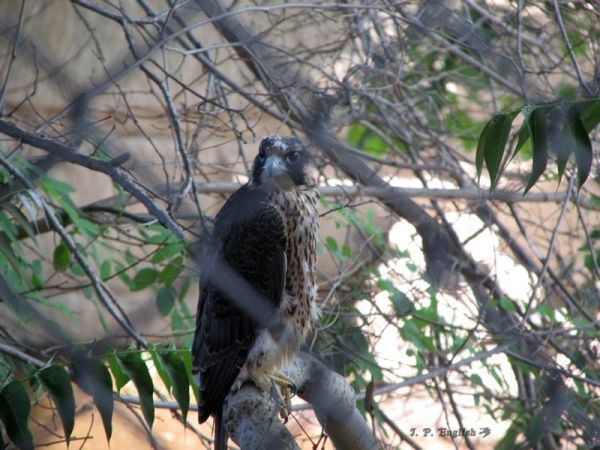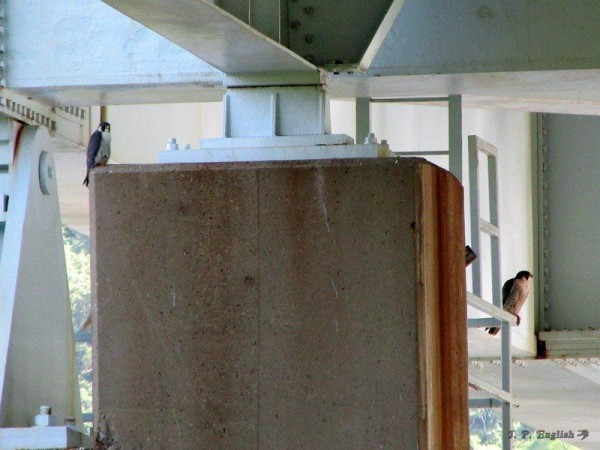
The peregrine situation looked sad yesterday at the Neville Island I-79 Bridge when site monitor Anne Marie Bosnyak checked for fledglings. She found one far below on the river’s edge — dead. Apparently it had landed on the ground and a predator killed it(*). … 1 Down.
But things looked much better today. One of the remaining two birds had fledged to a tree. … 1 Up.
His parents Beau (top left) and Magnum (bottom right) kept a close eye on him.

Meanwhile two nestlings remain at the nest, though only one was seen today. The youngest, a female, will fly last because she has less feather development and is heavier. … 2 to Go.
(*) In the first 24 hours of flight, fledgling peregrines lack the wing strength to take off from the ground. If they fledge to the ground they just stand there and may fall victim to predators or vehicles.
(photo by John English)
I’m glad there is good news to balance the bad. We can hope for the best for the other two. I like “Beau” for the adult male’s name.
There were 4 eyases banded. So 1 down, 1 up and hopefully 2 to go … although we did only see 1 in the nest area.
Ooops! My mistake is now corrected.
Kate, if you could put me in touch with Anne Marie, (I had her email address, but seem to have lost it!) I would like to try and fill in some of the times she/other watchers are unavailable.
Very sorry now that I did not stop by over the weekend; I wasn’t expecting all of this activity yet!
Why wasn’t there a fledge watch there?
Gindy, there is a fledge watch at Neville. That’s why we know as much as we do. Unfortunately, bridge birds get in trouble in ways we cannot help. Keep in mind there is a 60% mortality rate in the birds’ first year. 60%. 60%. Humans cannot protect them once they fly. We are stuck on the ground.
I so wish there was something like this around here in SC. There are some falcons in the Wells Fargo Building in Charlotte, but not PIX….the only way to watch them is through a livestream cam. But they are not banded, so who knows, one of them may end up in Pittsburgh one of these years.
If a eyas lands on the ground at fledge (like the one in the above posting), will a parent keep an eye on it and take it food or just leave it alone for whatever happens? Can a fledged juvenile not get any wind when on the ground? I would think they would be able to “branch” up somewhat.
Parent peregrines do keep an eye on grounded youngsters but if a youngster is in an unsafe place they refuse to feed it until it comes to a safe place or to them. They use hunger/food as a tool to get the juvie to safety.
Young peregrines don’t have wing strength to take off from the ground in their first 24 hours of flight. If there is something to ladder up on, they will do it. But there isn’t always a ‘ladder’ available. That’s why peregrines nest on high cliffs. 200 feet high is good for their kids.
Thanks….great info!